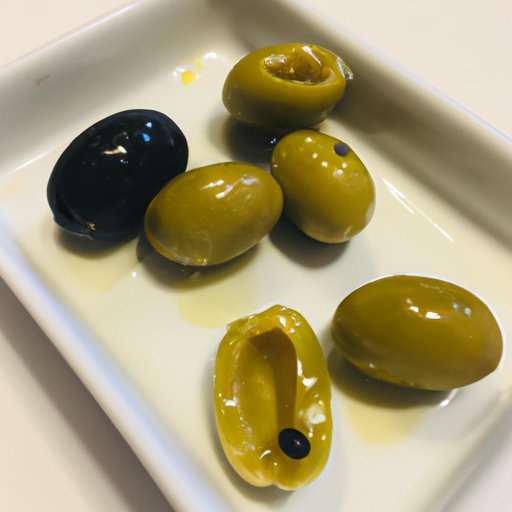Introduction
Olives have been a staple in Mediterranean diets for centuries and are now becoming increasingly popular due to their health benefits. Olives and olive oil are rich sources of healthy fats, vitamins, minerals, and antioxidants that can help protect against disease. However, there are some potential risks associated with eating too many olives, and it’s important to be aware of these before you incorporate them into your diet.

Exploring the Health Benefits and Risks of Eating Olives
Olives are a nutrient-dense food that offer a range of health benefits. They are low in calories and carbohydrates but high in healthy monounsaturated fats, making them a good choice for those on a low-calorie or low-carbohydrate diet. Olives are also an excellent source of vitamin E and other antioxidants, which can help protect against cellular damage from free radicals and reduce inflammation in the body.
In addition, olives contain polyphenols, which have been linked to inhibiting the growth of certain types of cancer cells. Olives are also a good source of dietary fiber, which can help improve digestion and lower cholesterol levels. However, olives can also be high in sodium, so it’s important to monitor your intake if you have high blood pressure or other conditions that require you to limit your sodium intake.
A Nutritionist’s Guide to Eating Olives
The recommended serving size for olives is one ounce (approximately 10-12 olives). This serving size contains around 70 calories and 5 grams of fat, as well as small amounts of protein, fiber, and vitamins and minerals. When choosing olives, look for ones that are labeled “low-sodium” or “no-salt-added” to ensure you’re not consuming too much sodium.
Olives can be eaten on their own as a snack, added to salads or pasta dishes, or used as a topping on pizzas or sandwiches. Olives can also be blended into sauces or dips for a flavorful addition to any meal. If you’re looking for a healthier alternative to traditional salad dressings, try blending olives with olive oil, lemon juice, and herbs for a tasty and nutritious dressing.
How Much Olive Oil Should You Include in Your Diet?
Olive oil is a key component of the Mediterranean diet and is widely considered to be one of the healthiest oils available. It is a rich source of monounsaturated fatty acids, which can help reduce inflammation and lower cholesterol levels. Olive oil is also a good source of polyphenols and antioxidants, which can help protect against cell damage and reduce the risk of chronic diseases. The recommended serving size for olive oil is one tablespoon per day.
When choosing olive oil, opt for extra-virgin or cold-pressed varieties, as these are minimally processed and retain more of the beneficial polyphenols. Avoid using refined olive oils, as these have been stripped of most of their beneficial compounds during processing. Olive oil can be used for cooking, baking, roasting, and sautéing, or added to salads, soups, and sauces for flavor.
Are All Olives Created Equal? Examining Different Varieties
Not all olives are created equal. Different varieties of olives vary in flavor, texture, and nutritional content. Kalamata olives are dark purple and have a meaty texture and a slightly sweet and salty flavor. They are high in monounsaturated fats and polyphenols and are a good source of iron, calcium, magnesium, and vitamins A, C, and E.
Green olives are smaller and lighter in color than Kalamata olives and have a slightly bitter flavor. They are a good source of monounsaturated fats, dietary fiber, and vitamins A, C, and E. Pitted olives are a type of green olive that has had the stone removed, making them easier to eat. They are a good source of dietary fiber and vitamins A, C, and E.
What to Know Before Adding Olives to Your Diet
If you’re considering adding olives to your diet, it’s important to be aware of any food allergies you may have. Olives can cause allergic reactions in some people, so it’s best to consult with a doctor before trying them. Additionally, it’s important to monitor your sodium intake when eating olives, as they can be high in sodium. If you have high blood pressure or other conditions that require you to limit your sodium intake, it’s best to avoid olives or choose no-salt-added varieties.
Conclusion
Eating olives can provide a range of health benefits, including providing essential vitamins, minerals, and healthy fats. However, it’s important to be aware of the potential risks associated with eating too many olives, such as an increased sodium intake. Nutritionists recommend limiting your daily intake of olives to one ounce, and opting for no-salt-added varieties whenever possible. Additionally, it’s important to consider any food allergies you may have before incorporating olives into your diet. By following these guidelines, you can enjoy the nutritional benefits of olives while avoiding any potential risks.
(Note: Is this article not meeting your expectations? Do you have knowledge or insights to share? Unlock new opportunities and expand your reach by joining our authors team. Click Registration to join us and share your expertise with our readers.)
